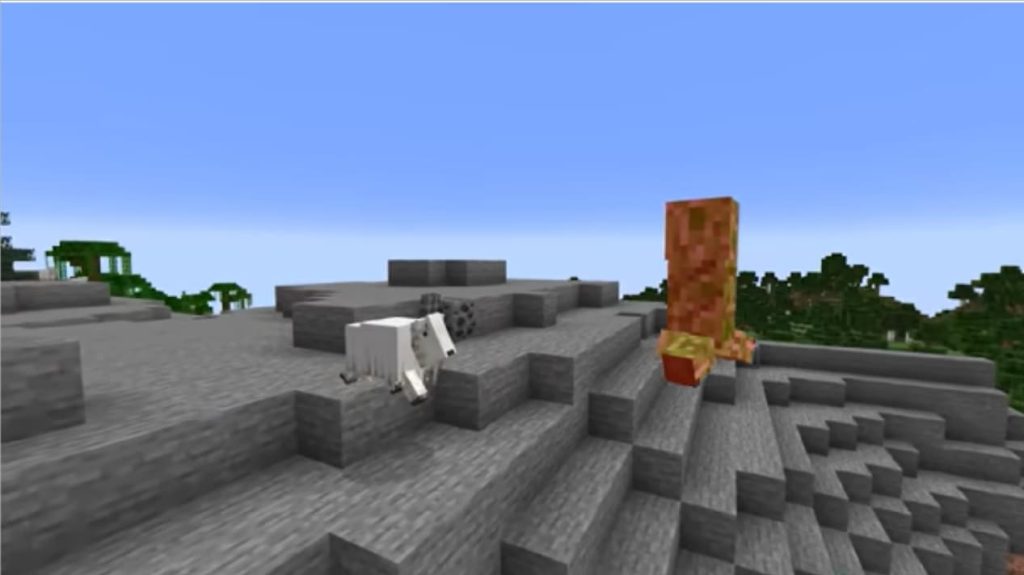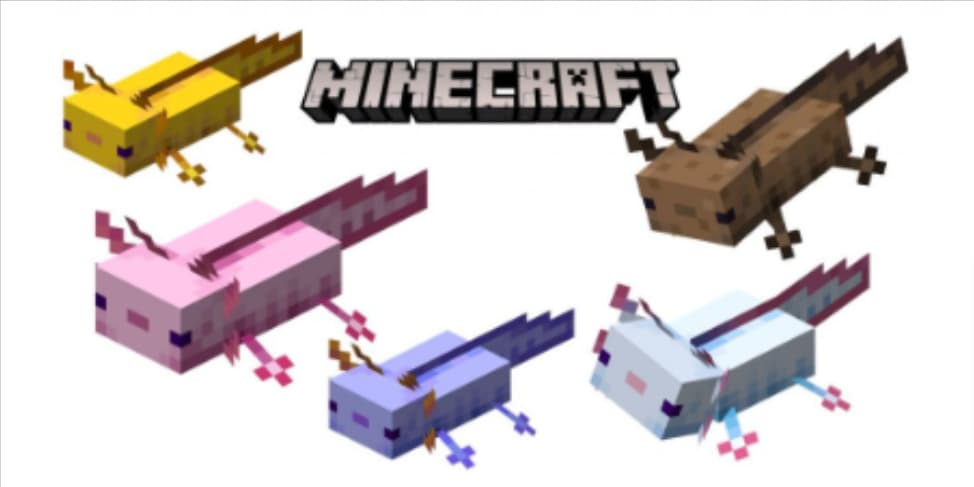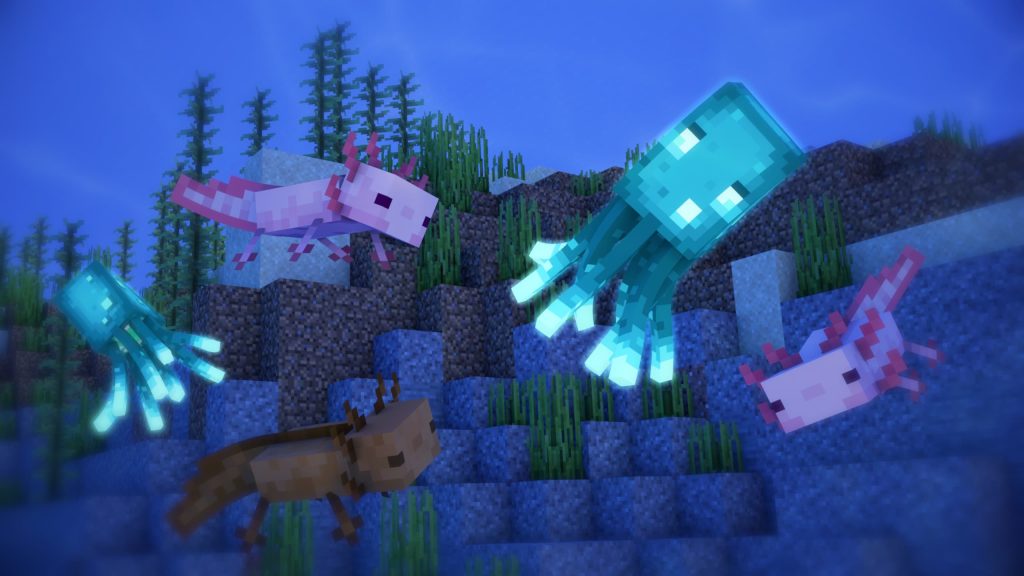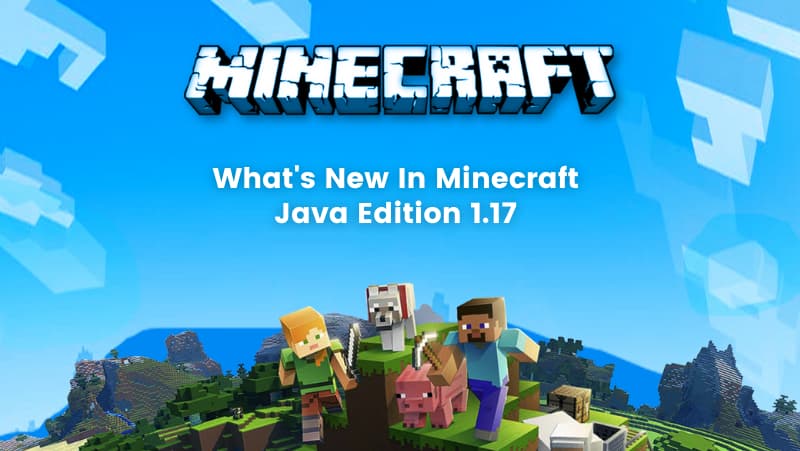The significant update, version 1.17, brings a wide variety of new material to the game. You’ll see brand-new world creation patterns that employ the updated blocks. There will also be brand-new items and sea mobs that make playing in the cubic world even more fun.
Caves & Cliffs: Part I came out on June 8, 2021. It was a big update to Java Edition. At Minecraft lantern Live 2020, it was disclosed. Since the caverns and cliffs upgrade was divided into two sections, the majority of the terrain modifications and adjustments to the world creation are found in part two.
Let’s go through the three new mobs in Minecraft 1.17 and the new update for the caves.
Table of contents
What are the Three New Mobs in Minecraft 1.17?
- Goats

The goat is a new passive mob that has five hearts of health or 10 hit points. In the mountains, goats give birth in groups of two or three, and there is a 5% chance that one of them is a baby. There’s also a 2% chance that one will be a screaming goat, a unique version of the goat that looks the same but sounds very different.
Goats do things that aren’t like those of other animals. For example, they will sometimes make a big jump that isn’t part of a plan to get somewhere. It also has a cooldown, so it won’t happen too often. Because they like to make these big jumps, they have a natural resistance to fall damage of 5 hearts or 10 hit points.
Goats also act in a unique way when they decide on their own to charge something that moves or an armour stand. It will get there and charge. It gives the target a big knockback. This is just a knockback, and mobs don’t fight back after being hit. This has a very long cooldown, so it doesn’t happen very often, but the screaming goats do.
Goats are also different because, when they walk around, they avoid powder snow. Goats can be tempted to eat wheat, and when fed wheat, they will also get pregnant. There are two ways that the child could turn into a screaming goat when it bakes. Lastly, goats are a new source. You can use a bucket to milk them, which gives experience but no loot drops.
- Axolotl

Axolotl is a new neutral mob with seven hearts of health and 14 hit points. Axolotls are born in underground lakes and pools in groups of one to four.
This means that they can only spawn in water that is completely dark and can’t be seen from the sky. They can also only spawn in water that has only water sources that are no more than five blocks above a naturally-generating stone type, such as granite, diorite, deep slate, or tough stone.
Axolotls are part of a brand-new type of mob.
So, their most common colours are pink, which is called Lucy Brown, wild gold, and cyan. There is an equal chance of getting any of these from any spawn.
Also, you have a 1 in 1,200 chance of seeing blue Axolotls, which is a rare variant.
Axolotls are amphibious creatures that can move on land and in water, but they move much more slowly on land. They don’t like being out of water and will start to dry out and get hurt if they are out of water for more than five minutes. While on land, they will try to get to any nearby water source. If you need to keep them out of water for more than five minutes, you can spray them with water to keep them from drying out.
If you kill a target that an axolotl was attacking or that had attacked the axolotl, the axolotl will give you a temporary regeneration and remove any mining fatigue effects.
The healing effect lasts for up to 2 minutes, depending on how many axolotls were targeting the enemy you killed.
When an axolotl is in the water and gets hurt, it will sometimes pretend to be dead so it won’t be attacked anymore. When an axolotl acts like it’s dead, other mobs won’t care about its axe level.
- The Glow Squid

The glow squid is a new passive mob that has 5 hearts of health and 10 hit points. In submerged lakes and pools, they typically appear in groups of two to four. They have the same conditions for spawning as axolotls and are part of the same new mob cap as other underground water creatures.
Glow squids light themselves up and can be seen from very far away. Aside from that, they function exactly like regular squid, with all of their folly.
When you kill an eagle squid, it will drop one to three glow ink sacks, or more if you have a weapon that lets you loot.
So, let’s move on to our new blocks, items, and glowing squid. The glow-ink serum can be used on a sign to make the words stand out even in the dark. It makes the text shine and can also be used with colors. If you don’t like the effect, you can get rid of the glow by putting a regular ink serum on the design. You can also make an item frame glow by putting the item frame inside a glowing sac. This is an item frame that, like the squid, lights up on its own and can be seen even at night.
What are the latest cave updates in Minecraft Java Edition 1.17?
- Ore
One of the new updates to caves is that all of the ore types that didn’t have unique shapes got new textures to make them easier to see. That means you can now tell each ore apart by its shape alone, and you don’t need to be able to tell them apart by their colors. But there are more changes that can be made to auras or status.
Now, the default is to drop an ore item instead of an ore block. This applies to iron, gold, and the new copper.
So you get your raw iron, raw gold, and raw copper. This means that Fortune now works with all types of ore, and you can mine with Silk Touch to get the original ore types.
And smelting is still an option if you want to use the original ores.
- Copper
Copper ores can be found in blobs all over the world, like iron and coal, but war is spread out differently; it starts at level 0 at the bottom of the world and goes up to level 98 at the top. This is, however, a triangle-shaped distribution.
Therefore, you are most likely to find this ore in the middle of the distribution at height 48. This is where you want to be to find the most copper.
A copper ore yields 2-4 grammes of raw copper when mined. You can also obtain more of them by mining with Fortune. Those can be smelted to get a copper ingot, and nine copper ingots can be put together in a 3×3 grid to make a copper block.
The copper block can then be broken down into 9 copper ingots again if you want, but you could also make 2×2 copper blocks or put them through a stone cutter to get cut copper, which can be used to make cut copper stairs and cut copper slabs. All of these different kinds of copper blocks work in their own way.
They oxidize over time based on random ticking, just like grass grows or leaves fall off. As oxidation happens, a copper block will turn more and more green.
However, you can spread out your blocks if you want them to work faster, and you can wax the copper block if you don’t want it to rust anymore.
Copper can also be cleaned of its oxidation by getting hit by lightning. When lightning strikes near copper, it cleans a patch of copper that isn’t in the same place twice.
- The Lightning Rod
The lightning rod made from three copper ingots can be placed in any direction, just like end rods, and it is placed the same way end rods are. Lightning that is about to strike in a circle with a radius of 128 blocks around the lightning rod will instead strike the rod. The lightning will have about the same effects on the rod as it would have had it struck the original location.
But one thing that won’t happen is that skeleton traps will not appear. You can also water-log a lightning rod if you want to. Remember that a lightning rod needs a clear view of the sky in order to be hit by lightning. When lightning strikes a lightning rod, it flashes and sends out a Redstone signal.
- Amethysts
Amethyst geodes form underground, close to caves. From the outside in, an amethyst geode has three layers: smooth basalt, a new type of stone; calcite, another new type of stone; and then amethyst blocks. There are two kinds of amethyst blocks: regular amethyst blocks and amethyst that are growing. The blocks where the crystal shards will Budding amethysts are those that are in the process of growing. One thing to keep in mind about these blocks is that you cannot move them in any way. They can’t be moved by pistons, and you can’t mine them either. If you ignore it, it will just go away. A small amethyst bud can grow on any side of a budding amethyst block where there is air or water.
Then, that bud will grow in three stages until it turns into a cluster of amethyst.
When these amethyst clusters are fully grown, you can mine them with an iron pickaxe or better to get 4 amethyst shards and 2 crystal shards. You can also pick up the amethyst buds if you break them by hand or with a piston. You can pick them up at any stage with a silk touch, but they won’t grow unless you put them on a growing amethyst. Then, you can turn four amethyst shards into four amethyst blocks.
The amethyst shards can be used as:
- Spyglass
Spyglass is made from two pieces of copper and one piece of amethyst. A spyglass is a new tool that can be used to get closer. When you hold it in your hand and use it in first-person mode, you can see a faraway place.
- Tinted Glass
You can make tinted glass by putting four amethyst shards into a glass block. This will give you two tinted glass blocks. Tinted glass is a new kind of glass that blocks out light. This means that you can now create dark areas that you can still see into in other ways. Tinted glass is mostly the same as regular glass, but there is one interesting difference.
Tinted glass can be made without a silky feel, and it can be broken.
- Dripstone
One of two brand-new block and item types is dripstone. They are made up of whole blocks, dripstones with pointed tips, and drip zones that, when put together, make stalagmites and stellar tights. You can only mine the blocks of dripstone with a pickaxe, but you can mine the points of dripstone with any tool.
If you desire dripstone blocks but only have pointed dripstone, you can make a dripstone block out of two-by-two pointed drip zones. A pointed drip stone will change into a stalactite if it is placed on a ceiling and a stalagmite if it is placed on a floor.
You can build longer stalactites and stalagmites by placing more pointed drip stone blocks on top of each other. If you build them all the way so that they connect to each other, then the tips will merge unless you’re holding shift.
If you break the block that a stalactite mite is on, then it will break; it will hurt if you fall on top of it, but it will also hurt if it falls on your head. Another way of breaking a pointed dripstone is to throw a trident on it. As a result, a portion of the stalactite beneath where you hit will fall. This will harm you as well as others. If you die in this manner, remove the extra durability from your helmet. Either the player name was skewered by a falling stalactite, or if you were involved in combat, both the player name and the entity name were skewered by a falling stalactite. The same goes if you fall onto a stalagmite, which hurts you more than normal fall damage.
- Deepslate
A brand-new stone family with numerous variations is called deep slate. It spawns in blobs ranging from 0 to 16 levels deep in the world. It is more difficult to mine than stone; in fact, one crucial aspect of it is that even with the highest level of all the necessary tools and effects, when you mine it without silk touch, you get cobbled deep slate, which can then be smelted back into deep slate itself. Cobbled deep slate looks the same on all sides, but normal deep slate has a different top texture, which also means that deep slate is a new family of stones with lots of interesting properties.
It is placed in a directional manner, so you place it much like you would place a log or a bone block combo. It is a slightly harder block, but it takes a little longer to mine, just like cobblestone takes longer to mine than stone and cobbled. Deepslate is also a crafting material; just like Blackstone or cobblestone, it can be used to craft stone tools and furnaces.
There are many variant blocks of deep slate. Deepslate also has stairs, slabs, and walls that you can make either by crafting or by stone cutting. You can also craft or stone cut it into polished deep slate, which is a 2×2 craft.
Deepslate bricks also have stairs, slabs, and walls, but in addition to this, they also have a correct version. You get that by smelting it but wait, there’s more. You can craft this one 2×2 as well, or stone cut it into deep slate tiles that in turn have stairs, slabs, and walls, and also another cracked version that you can get by smelting it.
Conclusion
Minecraft creeper 1.17 brings a wide variety of new materials to the game. Caves & Cliffs: Part I, a significant update to Java Edition, was released. Since the caverns and cliffs upgrade was divided into two sections, the majority of the terrain modifications and adjustments to the world creation are found in part two. To learn more about new additions in edition 1.17, check out the latest fun blogs on the BrightCHAMPS blog page.
To get your hands on more such articles, educational content, and free resources on coding classes for kids, online robotics classes for kids, game development, etc., check out the BrightCHAMPS Page now!
Frequently Asked Questions(FAQs)
One of the new updates of caves is that all of the ore types that didn’t have unique shapes got new textures to make them easier to see.
You can turn four amethyst shards into four amethyst blocks.
The amethyst shards can be used as
1. Spyglass
2. Tinted Glass
Three mobs in Minecraft Java Edition 1.17 are:
1. Goats
2. Axolotl
3. The Glow Squid













